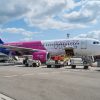 Not so long ago, the prime concern of those responsible for aviation safety was the technical characteristics of planes. Since the adoption of electronic, and later digital, fly-by-wire systems beginning in the late 1960s, however, which replaced manual controls, the aviation industry reached maturity. What innovation still takes place is mostly detail work – tinkering around the edges of a solid foundation. For this reason, the last several decades saw the focus increasingly shifting towards Organization Management Systems – and the human factors in general.
Not so long ago, the prime concern of those responsible for aviation safety was the technical characteristics of planes. Since the adoption of electronic, and later digital, fly-by-wire systems beginning in the late 1960s, however, which replaced manual controls, the aviation industry reached maturity. What innovation still takes place is mostly detail work – tinkering around the edges of a solid foundation. For this reason, the last several decades saw the focus increasingly shifting towards Organization Management Systems – and the human factors in general.
To get the low-down on where the industry stands now – and where it might be heading shortly – we spoke to Jurgita Baleviciene, Head of Safety at Avion Express. In addition to having a master’s degree in aviation company management, she worked as a cabin crew for many years, later becoming a crew instructor and safety manager when her exceptional attention to detail was noticed by management.
When it comes to aviation, safety ≠ security
As Jurgita tells us, when it comes to aviation safety, the first thing to get straight is the somewhat tricky distinction between safety and security:
“Security essentially refers to external threats and risks – think bringing illicit objects onboard the plane, and the dangers of terrorism. Safety, on the other hand, is much broader, encompassing all safety-related matters internal to the organisation itself. This includes everything, from scheduled aircraft maintenance and crew training to keeping the window blinds open during take-off and landing to allow the cabin crew and passengers to assess if there are any dangers”.
However, the safety of the flight cannot be ensured without effective security measures being in place.
Flight preparation is one of the main prongs of ensuring crew and passenger safety. The technical part is performed by engineers. This involves rigorously scheduled maintenance, where almost every single part of the plane is assigned its frequency of inspection – one per month, week, or even daily. Ground handling, for its part, refers to things like passenger and cargo handling, cleaning, towing, refuelling, catering, de-icing of aircraft, and thorough security checks of passengers and their belongings to be carried onboard. The crew also makes its contribution during flight preparation. Pilots carefully study the flight path, weather conditions at all relevant airports, assess fuel needs and the impact of current aircraft defects on the flight and inspect the plane’s technical data, and decide how much fuel will be needed. Meanwhile, flight attendants, for their part, inspect the condition of safety and emergency equipment, conduct security checks, and audit the required passenger service items.
Key changes over the past 20 years
Back in the late 1990s, Jurgita tells us, smoking was still allowed on the plane, resulting in a thick fog inside the cabin and increased risk of cabin fires. Its prohibition, however, was not the most significant change since then.
In terms of technical evolution, she mentions a new generation of planes and systems, including the switch to digital screens, and the transition most aviation companies had made to electronic flight bags. In addition to searching for information a breeze, these also provide all the latest flight data, such as weather conditions and flight path, reducing the likelihood of error.
Furthermore, there has been a massive shift in gender relations on the job. “Although most pilots are still men, the percentage of women in that position has been steadily growing, as people increasingly focus on people’s skills, not their gender. With regards to the company managerial side of things – at the first managerial meeting it was just me and the rest were men. Now the situation is quite different, and this is also true of the Safety Department”.
And yet, according to Jurgita, a very important change for the industry, by far, is the increased focus on human factors. With the planes themselves technically perfected to a very high level – and with extremely strict legal regulations in place for operational and crew training aspects – it became possible for aviation companies to significantly reduce human factors’ s influence on flight safety.
“And this is not just about fatigue or pilot error, which is what most people think. Human error doesn’t take place in a vacuum, it’s highly mediated by organisational structure and processes and includes the entire personnel. If somebody had failed to put the right kind of screw in, we must think about what the company could’ve done differently to reduce the risk of such a thing happening in the first place,” Jurgita says.
This is where modern Safety Management Systems come in. Encompassing both the technical and operational aspects of aviation, they’re able to provide a much broader overview of the total process, enabling companies to continuously look for better ways of doing things. For instance, this can include adjusting deviation tolerance levels or identifying the exact type of personnel training that would lead to further improvements.
This is very much Jurgita’s forte. “Being an instructor myself, I’ve become aware of the fact that you can’t just tell people what they’re supposed to do. ‘If X, then Y’. This is because they want to see the meaning in their work. And to understand the reasons why something is done. We need to raise their consciousness and awareness. This will also help them in unusual situations, for which there are no instructions”.
Future trends in aviation safety
According to Jurgita, the main thing to look forward to is AI. While it’s still early days, there’s been plenty of activity in the area in recent years.
“Using AI in aviation isn’t a new thing. Its growing adoption in the industry, though, is quite recent – a highly promising development! One of its results is that we’re barely using any paper these days, and larger companies have moved away even from such staples as Excel spreadsheets. Everything is now managed through applications that aggregate, analyse, and systematise the huge amounts of data collected by aviation companies. This is extremely beneficial to decision-making”.





